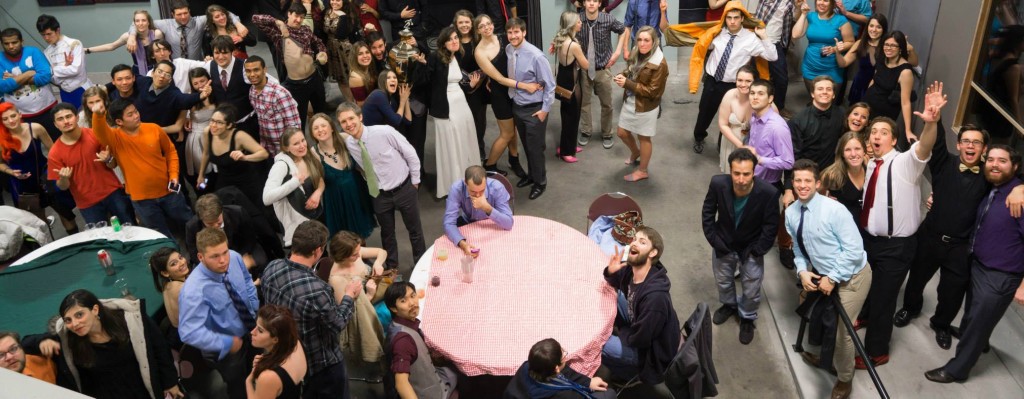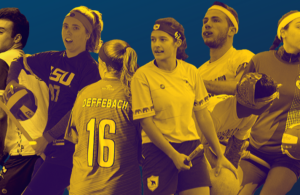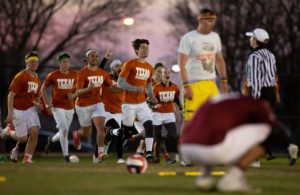- Rule, Britannia, no more?
- Unpopular Opinions: US Quadball Cup 2023
- Proven Contenders: University of Virginia
- Proven Contenders: Rutgers University
- Proven Contenders: University of Michigan
- Proven Contenders: Creighton University
- Different Perspectives: A Look Inside USA Ultimate
- Antwerp QC, Much of Belgian Core, Leaves Competitive Quidditch
A World of Change: Storylines to Watch in 2015
- Updated: January 8, 2015

Original Photo Credit: Nicole Harrig
2014 was a big year for quiddtich. Acronyms like IRDP and USQ entered our collective vocabularies. All-star teams from seven nations on both sides of the Atlantic traveled to western Canada for the second edition of the Global Games. Some of the first teams in Africa and Asia began to sprout up. Kansas-ing, 1.5 bludgers and a heavy dose of two-male beater sets forced us to rethink how we played the sport.
But at the same time, it was a year in which the status quo was very much maintained. The University of Texas defended its World Cup title without losing a game, while Team USA did the same at Global Games. IRDP pushed for a privatization of the sport’s refereeing management, but, for now, USQ maintains its referees under its own watchful eye. World Cup was once again over saturated with teams and under saturated with good quidditch matches, particularly on day one. And numerous quidditch blogs, both anonymous and not, popped up, only to disappear into the ether of studying or working.
So what does 2015 have in store? It’s a cop out to say that big changes are likely in store–that could be the tagline for just about any newly-developing sport–but it’s also likely the truth. As the top level gets more and more competitive and the number of players continues to increase, we are being forced to adjust accordingly. What does that mean for the new year?
Lone Star State of Mind
It’s fitting that we all woke up on New Year’s Eve to a smattering of advertisement for Lone Star Quidditch Club tryouts, because the team is going to be in our collective conscience early and often in the year to come. I know that’s not exactly saying much. After all, Lone Star is 20-0 already this season, perhaps the most dominant team to ever step onto a quidditch pitch, and will be looking to do what Texas A&M has failed to do in each of the past two seasons, turning a perfect fall into an undefeated season and, most importantly, a World Cup title–the first-ever for a community team.
But there’s way more to the story of Lone Star in 2015 than just their results on the pitch. If they were to finish undefeated, annihilating every team in their path as though they were World Cup VI Texas reincarnated–and, let’s be honest, in some ways, they are–they would find themselves smack dab in the middle of debates over the continued existence of community and college teams in a single league. While it’s probably unfair to have such conversations, as no other community team has reached that level, and none of us were calling for the separation of the Southwest from the rest of the league when Texas did it two years ago, the talks are likely to happen nonetheless.
Then there is, of course, the topic of continued poaching–sorry, Mitch, the term is not going away–and the destructive effects it can have. There are rumors swirling that Lone Star isn’t even done poaching this season, and if any of the Southwest’s top programs were to disappear at the hand of Lone Star recruiting, we’ll be forced to concern ourselves with the harsh reality of the practice. Community teams are doing nothing wrong, they’re simply looking to improve themselves, but if the price is entire college programs, it’s something our sport cannot afford.
Finally, and perhaps most interestingly, we have next season. Up until now, somehow, Texas has managed to operate with just one true community team program. But things are rather likely to change come September. With another graduating class of some of the best players in the sport, there’s simply going to be too much talent for a 21-player roster and too much value to be playing for a B-team. There’s also the likelihood that Texas’ graduating class, which has a history of bad blood with Lone Star, would rather start their own program if they were to stick with the sport. The founding and stabilization of a second Texas community program could be the start of one of the greatest rivalries in our sport to date and is an exciting proposition for the fall.
Simply put, almost every major storyline in the next year will, in some way, involve the best team in the nation. Whether they come out of it as heroes or villains, champions or goats, remains to be seen. But, personally, I’m eager to find out.
Fantasy Follies
This may make me sound like an old fogey, but fantasy tournaments aren’t what they used to be. Don’t get me wrong, fantasy tournaments still have a ton of value, serving as valuable practice, a chance to try new things and a place to get to know more of the quidditch community. Players get “turned up” with each other at pre-parties, after parties or, hell, during the tournaments. But due to the oversaturation of such events and their signup lists, fantasy tournaments just are not the marquee events they once were.

Credit: Jessica Jiamin Lang
Take, for example, Snow Cup. One of the best run fantasy tournaments–probably even one of the four majors–was inundated with an incredible number of signups the sheet moment went live. This highly limited the participation of out-of-region players, who could not be sure about attendance as quickly, and also watered down the skill level of the tournament. Even within region, not a single Team USA member from the West–other than Tony Rodriguez, himself a late add–was in attendance. This isn’t an isolated incidence, as even last summer it was affecting tournaments as big as Northeast Fantasy.
But this summer is likely to take watered down to a new level, with fantasy tournaments already being scheduled for just about every weekend of June, July and August. While this is great on one hand, it’s just not enough to be the central events of the summer calendar, especially in a non-Global Games year. At this point, fantasy tournaments more resemble major city’s pickup scrimmages than they do top-tier tournaments, and that’s just not enough to satiate everyone’s cravings for top-notch quidditch.
So where do we go from here? What events can fill the void? The answer, to me, is the most interesting part of the summer to come. Originally, there was a major push for a regional all-star tournament, featuring teams of the best players from each region, but no one seems to be making the organizational push to put it together. A league of community teams, built to include school players off from their teams for the summer, could also fill the gap, but would require an even larger organizational push.
There clearly isn’t an easy solution here, but a summer that is composed purely of these diluted fantasy scrimmages–with a potential high point come THE Fantasy Tournament–would be the least exciting summer in some time.
Revamped Regional Championships
In case you somehow missed it, I’m not exactly the biggest proponent of regional championships these days. They serve little purpose for the best teams, who spend a whole day achieving a qualification that was never in doubt, only to play maybe one or two meaningful games at the end of bracket play, and little purpose for the worst, who head home after a series of max-point differential shellacking. While it obviously means the world to teams on the border, they still only play a small amount of meaningful games. If we instead chose to let the best teams automatically qualify, we could have entire tournaments built around the middle-of-the-pack teams trying to make it to the big time. Even if an entire format change is not the best solution, it is clear that something had to give.
That is what leaves me so excited about the coming season. With the dual announcement last month that the Midwest would become two regions and the World Cup field would be cut down to 60 teams, regional championships just got very interesting again. Based on this year’s numbers, here is what the bid totals would look like, courtesy of Josh Maher, and not including any automatic bid input:
Great Lakes: 8
Midwest: 6
Mid-Atlantic: 8
Northeast: 10
Northwest: 3
South: 6
Southwest: 10
West: 10
Those numbers may seem pretty bland, but what they really stand for is the return of intriguing competition to regionals. Take the Great Lakes, for example. One of the following teams would not have qualified for World Cup if this was the method used this season: Ohio State, Bowling Green State University, Ball State University, Central Michigan University, University of Michigan, Blue Mountain Quidditch Club, Michigan State University, Miami University, Marquette University. And that’s only if chalk holds for the other eight listed. In the Southwest, Texas A&M would be on the bubble going into a regional championship at this point. This isn’t the Little Sisters of the Poor competing for bids anymore, these are proud, historic programs in the sport. Suddenly, every game is going to matter again, and that is great for a series of tournaments that has struggled to retain relevance throughout the year.
This is before even considering the World Cup itself. With the field reduced to 60 teams, it gives USQ the freedom to tinker with its format for the tournament. Pool play was full of pointless blowouts that never even needed to be played. While it has been efficient and necessary, the 48-team bracket of World Cup VII left a lot to be desired. Single-elimination brackets are rarely the best way to determine a champion and, once again, we ended up with an unevenly balanced bracket lacking the marquee inter-region matchups we’d been craving all season long.
By reducing the field to 60 teams, USQ has thrust its biggest tournaments back into the spotlight. Regional championships are going to matter again, and World Cup will be not just a marquee event, but a marquee competition. And, no matter what you think of the USQ itself, that is a win for all of us.
Watching the World
While growth of the sport has been somewhat stymied stateside–a topic worthy of its own article–that’s not the case in the rest of the world. Quidditch is now played on six continents, and this year will be a massive one in determining just how far the sport can go internationally.
It is hard to not be excited with what Europe has done in its first year out of the grasp of Alex Benepe. The sport is being played in more countries than ever. A recent Quidditch Post article reported that 11 nations will compete at the European Quidditch Cup, an international club-team tournament that will require qualification and may be the highest-level tournament ever played on the continent. This tournament is everything there is to love about sports–national pride, top teams, high stakes–and if there is a live stream, I will be glued to it.
East of Europe, things are finally starting to heat up in Asia as well. Vietnam and the Philippines recently became the third and fourth, joining teams from China and Malaysia. The continent has yet to see any international play, and, perhaps in part because of it, has not seen much growth. However, this could very well be the year for both, with the Vietnam side seeking out games with their Philippine and Malaysian counterparts.
While 2015 may not be a Global Games year, it is going to go a long way in setting the stage for one. The Asian teams likely aren’t ready to travel around the world for such a tournament, but the beginnings of international play could lead them down the road of attending a Eurasian edition of the tournament three to five years down the line. And while European national teams likely won’t be ready to compete with Team USA by 2016, it’s tournaments like the European Quidditch Cup that will spark the improved strategy and level of play necessary for them to do so.
If we’re lucky, maybe the 2018 Global Games will be contested by teams from all six continents and won by someone other than Team USA. I may be a proud American, but I know the power of a Cinderella story, a “Do you believe in Miracles?” I truly believe that nothing could be better for the sport, and it all starts in 2015.





One Comment